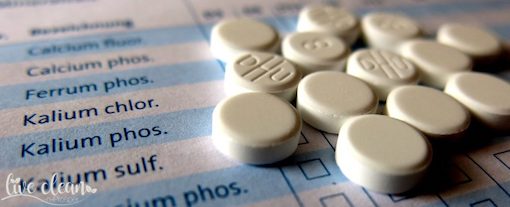Today’s post is about Tissue Salts.
Several years ago when I was suffering from a head cold, someone suggested I try Tissue salts to ease the symptoms. Recently Scott feel victim to a head cold and decided to try the tissue salts. He found that they really made a difference.
We did some research into these little pills to better understand how they work.
It turns out that these tissue salt pills are homeopathic preparations of minerals found naturally occurring in the human body. They’re inexpensive and seem to be able to help with just about every common ailment from colds and flu to headaches and hangovers.
What are they?
Tissue salts, also known as “cell salts” or “biochemistry salts”, are the same minerals that are found in rocks and in soil. These tissue salts exist on the border between homeopathic and nutritional medicine.
According to Biochemical therapeutics, the integrity, structure, and function of the body’s tissues and organs are dependent on necessary quantities of certain cell salts. These ‘cell salts’ are therefore integral functioning parts of each individual cell and of the body as a whole.
The history behind them
Dr Wilhelm Heinrich Schuessler was a doctor of medicine, a physiological chemist and a physicist.
In 1873 he developed the Schuessler Tissue Salts using a unique system of cellular therapy,
Schüssler deducted that the tissues or cells of the body can be broken down chemically into twelve inorganic mineral salts. Disturbances in the levels of these salts cause disease. He established that restoring the accurate balance of tissue salts in the body would remove the symptoms of illness and restore health.
He also believed that the body needed only very small doses to nudge it gently back into balance. Dr Schuessler found that a homeopathically prepared micro dose was the most effective way for the body to assimilate these salts. The dose passes rapidly into the bloodstream and therefore into our cells.
Wikipedia states that biochemical cell salts are alternative remedies, based on inorganic salts that were elaborated by Scheussler. They are not classed as homeopathic remedies.
There is no evidence of medical trials in regards to Tissue salts. Nevertheless, many people swear by them.
Who can use them?
To ease various conditions, you can take an individual tissue salt or a combination.
One of the major benefits of tissue salts is that they’re very safe. I did not find any information regarding side effects. However, as with most health matters, it’s always best to check with your health practitioner beforehand.
That said, tissue salts are generally suitable for everyone from babies to diabetics and even animals.
I hope that you found this information helpful as we did.
Till the next post,
Live clean n Prosper


